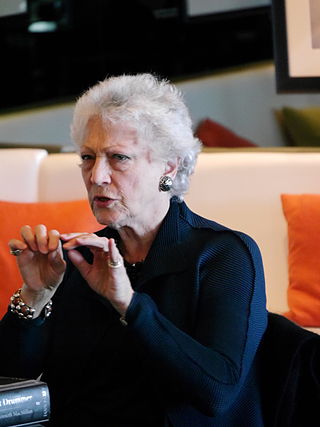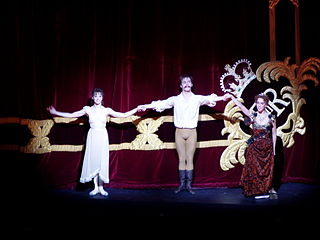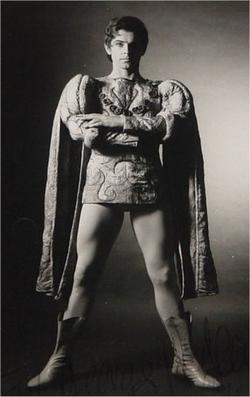Related Research Articles

The Royal Ballet is a British internationally renowned classical ballet company, based at the Royal Opera House in Covent Garden, London, England. The largest of the five major ballet companies in Great Britain, the Royal Ballet was founded in 1931 by Dame Ninette de Valois. It became the resident ballet company of the Royal Opera House in 1946, and has purpose-built facilities within these premises. It was granted a royal charter in 1956, becoming recognised as Britain's flagship ballet company.

The Royal Ballet School is a British school of classical ballet training founded in 1926 by the Anglo-Irish ballerina and choreographer Ninette de Valois. The school's aim is to train and educate outstanding classical ballet dancers, especially for the Royal Ballet and the Birmingham Royal Ballet.

Dame Monica Margaret Mason is a former ballet dancer, teacher, and director of The Royal Ballet. In more than a half-century with the company, she established a reputation as a versatile performer, a skilled rehearsal director, and a capable administrator.

Sir Kenneth MacMillan was a British ballet dancer and choreographer who was artistic director of the Royal Ballet in London between 1970 and 1977, and its principal choreographer from 1977 until his death. Earlier he had served as director of ballet for the Deutsche Oper in Berlin. He was also associate director of the American Ballet Theatre from 1984 to 1989, and artistic associate of the Houston Ballet from 1989 to 1992.
Sir Anthony James Dowell is a retired British ballet dancer and a former artistic director of the Royal Ballet. He is widely recognized as one of the great danseurs nobles of the twentieth century.
Dame Merle Park, is a British ballet dancer and teacher, now retired. As a prima ballerina with the Royal Ballet during the 1960s and 1970s, she was known for "brilliance of execution and virtuoso technique" as well as for her ebullience and charm. Also admired for her dramatic abilities, she was praised as an actress who "textured her vivacity with emotional details."

Lynn Seymour was a Canadian-born ballerina, mostly associated with the Royal Ballet in London. She was a muse of choreographer Kenneth MacMillan, creating lead roles in Romeo and Juliet, The Invitation, Concerto, Anastasia and Mayerling, among others. She originated lead roles for several ballets by Frederick Ashton, including The Two Pigeons, Five Brahms Waltzes in the Manner of Isadora Duncan and A Month in the Country. She also guested with various ballet companies throughout her life.

Mayerling is a ballet choreographed by Kenneth MacMillan to the music of Franz Liszt, arranged by John Lanchbery, scenario by Gillian Freeman and designed by Nicholas Georgiadis. The ballet is based on the Mayerling incident, a series of events surrounding the apparent murder–suicide of Rudolf, Crown Prince of Austria and his lover, Baroness Mary Vetsera. The ballet premiered on 14 February 1978, at the Royal Opera House, danced by The Royal Ballet, with David Wall as Prince Rudolf and Lynn Seymour as Vetsera.

Mary Elizabeth Miller was an English television and stage actress, who was a founding member of the National Theatre Company in 1963.
Maryon Lane was a South African ballet dancer who became well known in Britain as a ballerina of the Sadler's Wells Theatre Ballet and as a soloist with the Royal Ballet.
Choreographer Sir Kenneth MacMillan's Royal Ballet production of Sergei Prokofiev's Romeo and Juliet premiered at the Royal Opera House, Covent Garden on 9 February 1965.

Viviana Durante is an Italian ballet dancer, considered one of the great dramatic ballerinas of recent times. She was a principal dancer of The Royal Ballet, American Ballet Theatre, Teatro alla Scala and K-Ballet. She is the artistic director of English National Ballet School and of the Viviana Durante Company.

Ashley Macdonald Lawrence, was a New Zealand conductor mainly active in the UK and Germany, and particularly associated with ballet.
A Month in the Country is a narrative ballet created in 1976 with choreography by Frederick Ashton, to the music of Frédéric Chopin arranged by John Lanchbery. It is based on the play by Ivan Turgenev of the same name, and lasts for about 40 minutes.
Jazz Calendar is a ballet created in 1968 by Frederick Ashton to the music of Richard Rodney Bennett. The ballet was first performed on 9 January 1968 by The Royal Ballet at the Royal Opera House, Covent Garden, with designs by Derek Jarman. The work was performed over 50 times up to 1979 by the Royal Ballet at Covent Garden but is not part of the current repertoire. It was also produced in October 1990 at the Birmingham Hippodrome by Birmingham Royal Ballet.

Derek Rencher was a British ballet dancer. A commanding figure among Royal Ballet character dancers for more than four decades, he was probably the most prolific performer in the company's history.
The Rite of Spring is a one-act ballet created by Kenneth MacMillan in 1962 for the Royal Ballet, set to Igor Stravinsky's The Rite of Spring (1913). The conductor was Colin Davis, and the designs were by Sidney Nolan.
Anastasia is a ballet created by Kenneth MacMillan. The first version in one act was premiered in 1967 by the Deutsche Oper Ballet. In 1971 MacMillan expanded the work to three acts for the Royal Ballet; the original one-act version became the final act of the 1971 work.
Julian Hosking (1953-1989) was a British ballet dancer and a former principal dancer with the Royal Ballet.
Five Brahms Waltzes in the Manner of Isadora Duncan is a ballet solo choreographed by Frederick Ashton to music by Johannes Brahms, inspired by Isadora Duncan and created for Lynn Seymour. The first version, under the title Brahms Waltz, used only Brahms' Op. 39, No. 15, and premiered on 22 June 1975, at the Hamburg State Opera. The expanded version, which featured more Brahms waltzes, premiered on 15 June 1976, during Ballet Rambert's 50th anniversary gala, at the Sadler's Wells Theatre, London, and is dedicated to Marie Rambert.
References
- 1 2 "Isadora". Kennethmacmillan.com. Retrieved 15 October 2014.
- ↑ Right Royal Company, BBC1 programme description, accessed 4 March 2017.
- ↑ The WorldCat entry for Isadora filmed, accessed 4 March 2017.
- ↑ Royal Opera House Collections Online, Performance Database > Isadora > Isadora (1981) > Isadora 30 April 1981 Evening, accessed 4 March 2017.